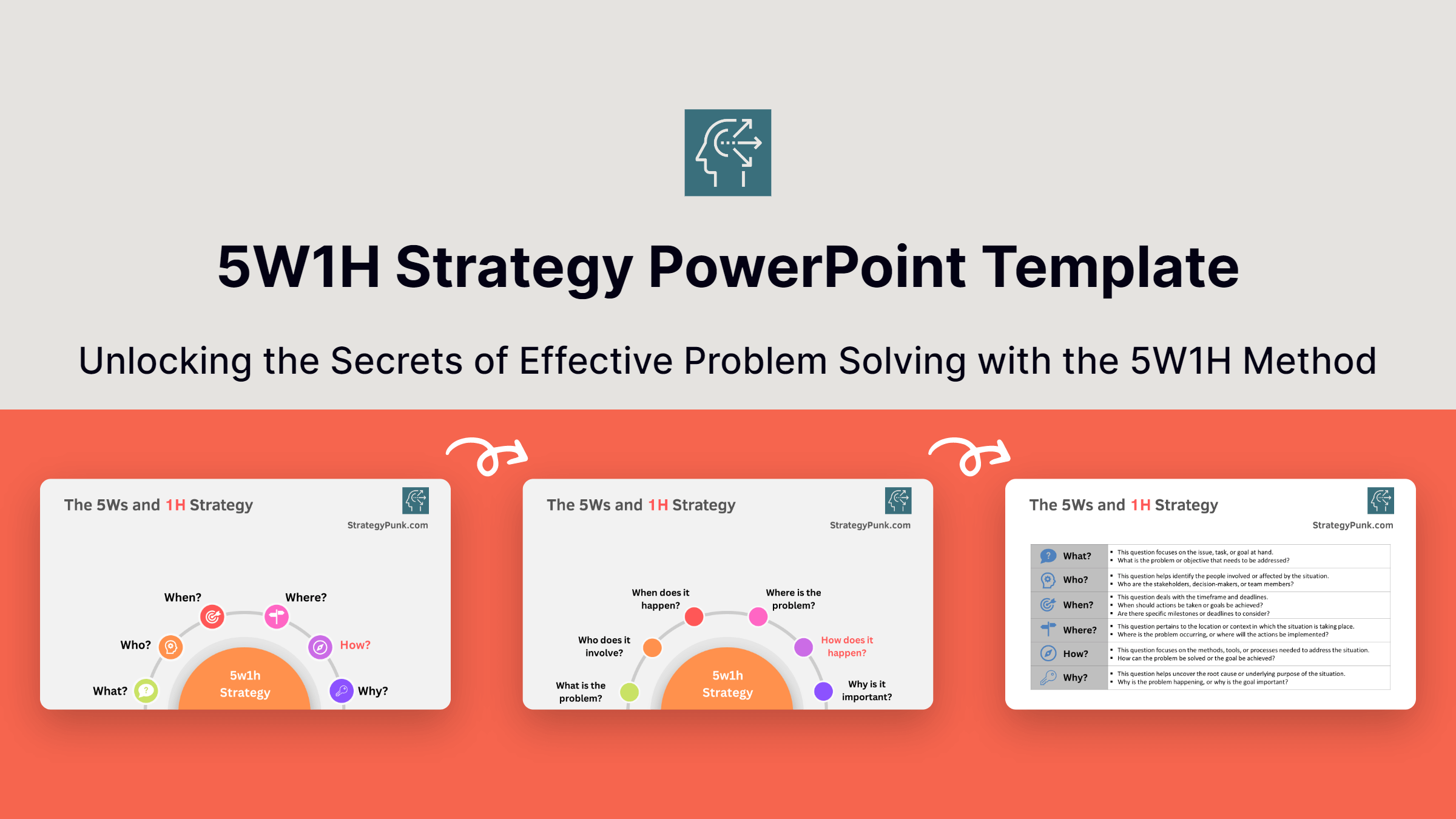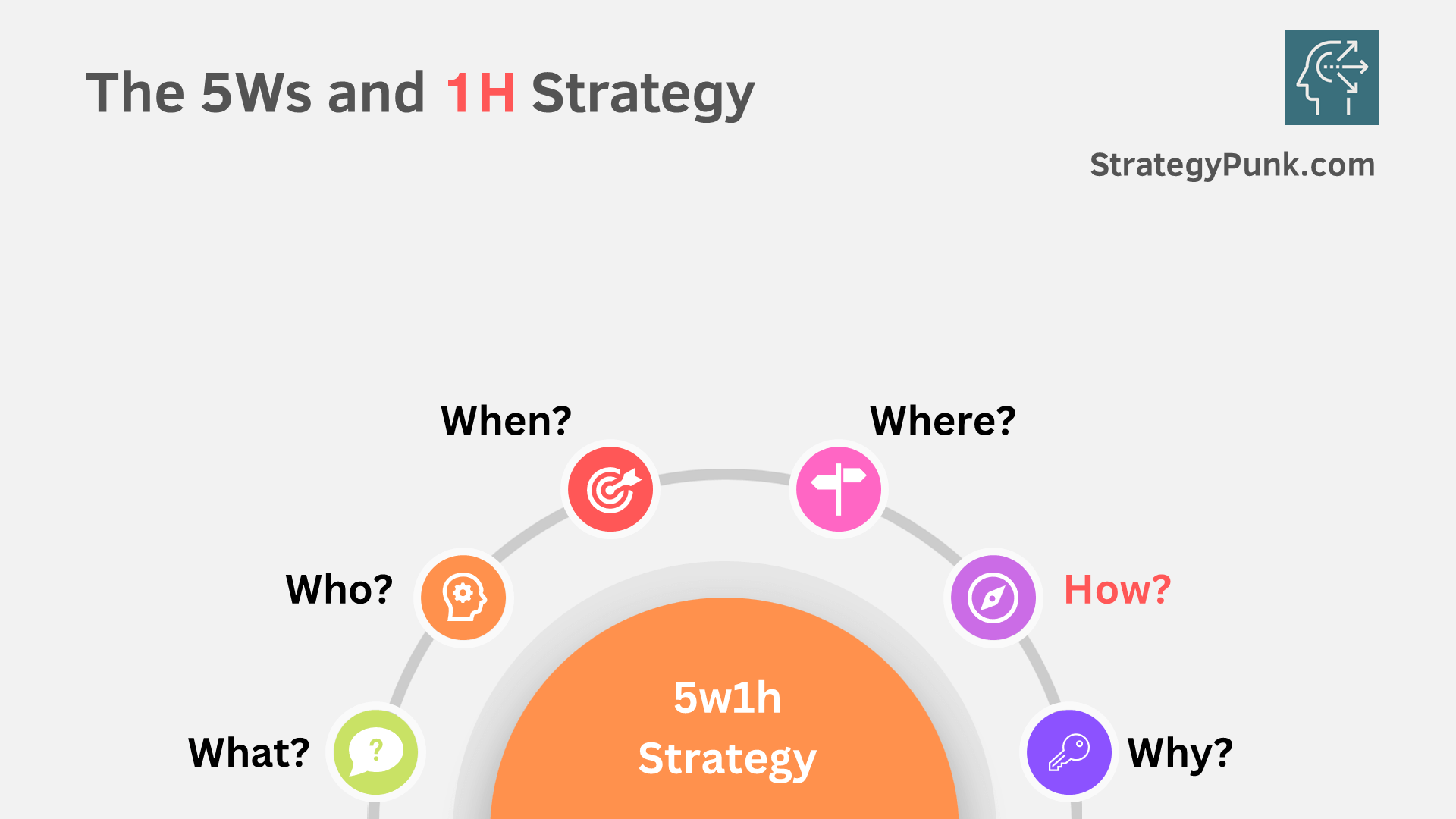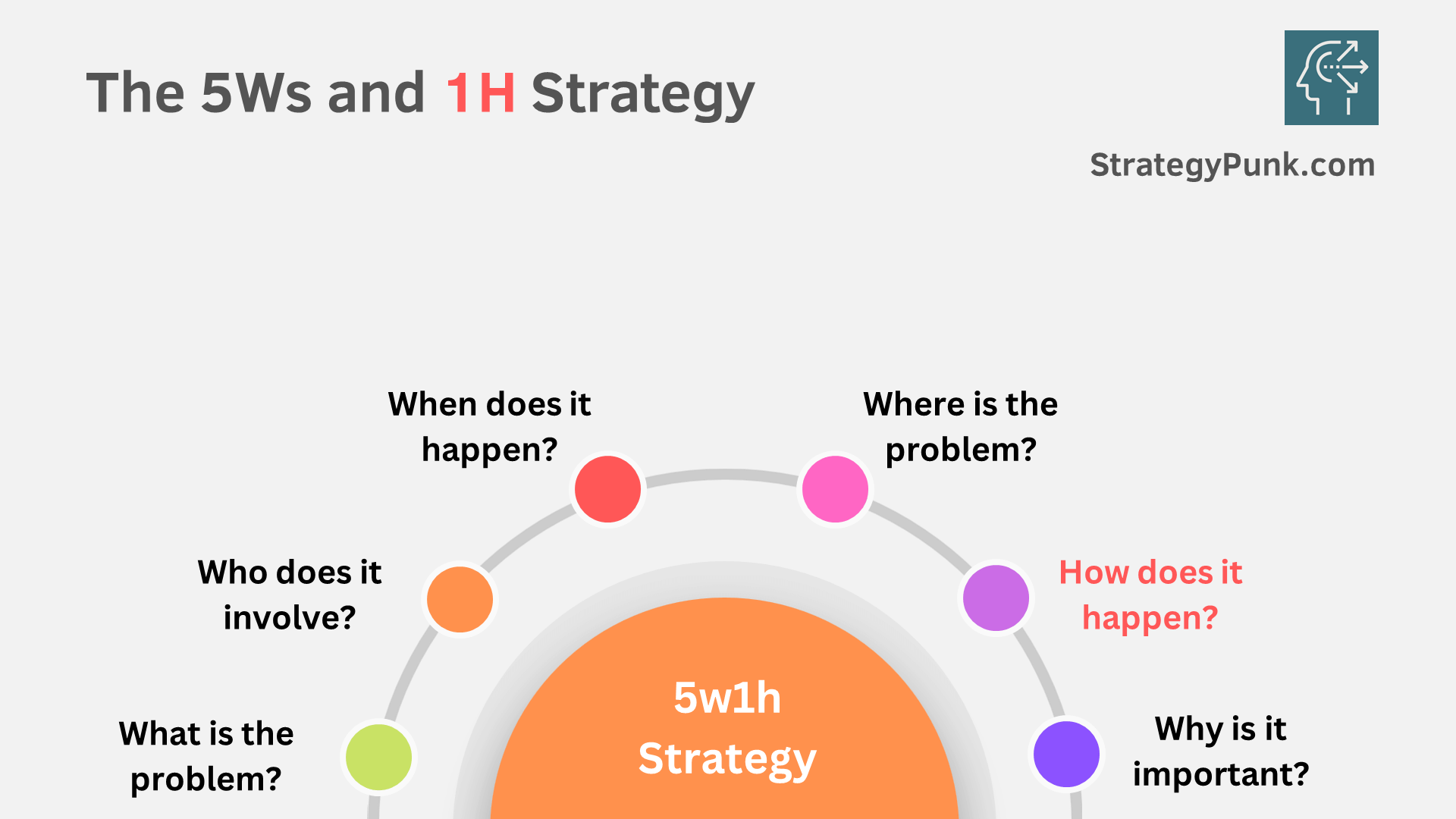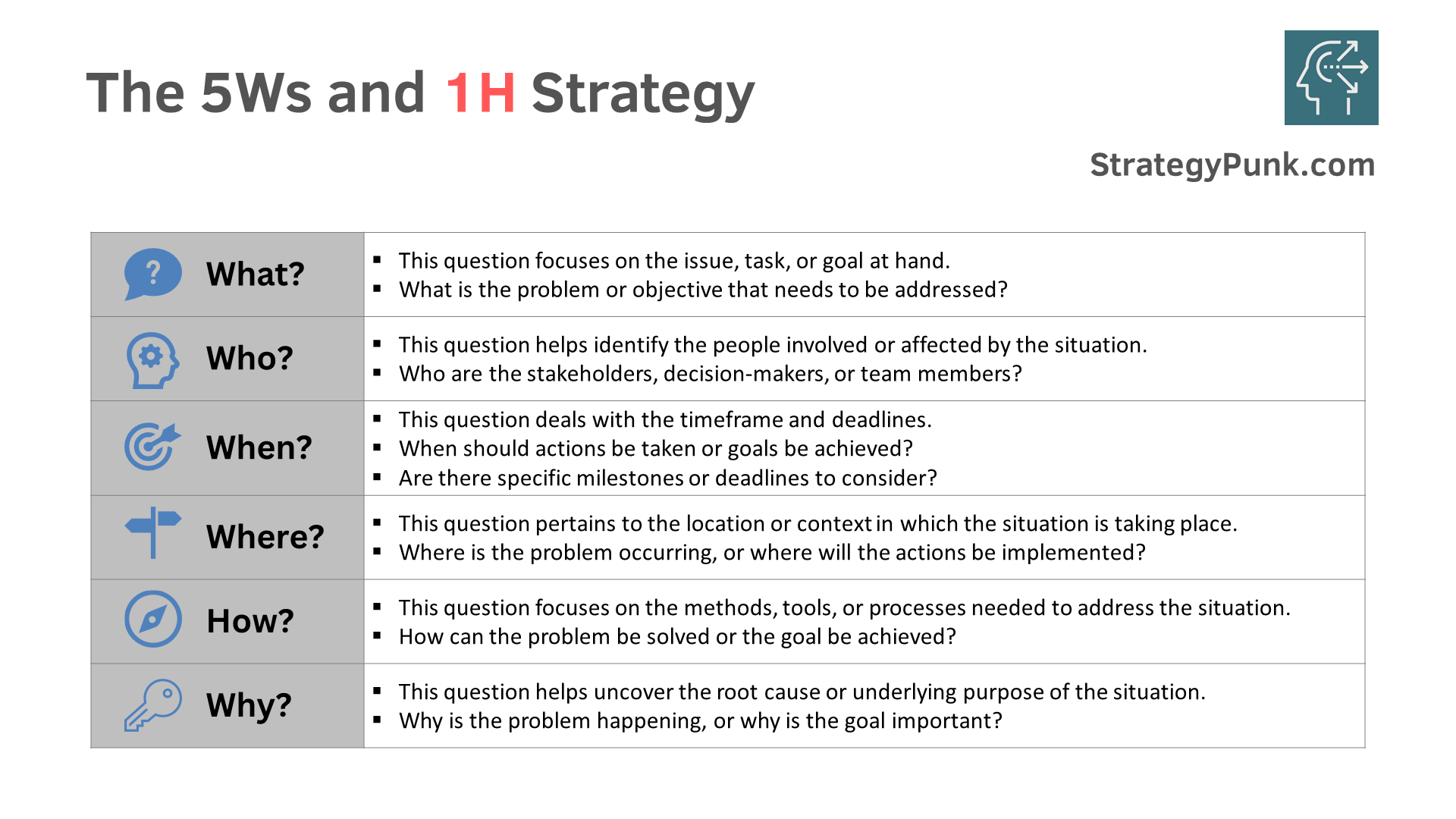5W1H Method: Unlocking the Secrets of Effective Problem Solving
Unlock the power of the 5W1H Method and transform your problem-solving skills! Get our FREE, fully editable PowerPoint template.

Introduction
The next time you're staring at a complex problem, wondering where the hell even to begin, remember this: the best solutions start with the right questions.
Most of us attack problems backward. We jump straight to brainstorming fixes without truly understanding what we're trying to fix. The 5W1H method flips this approach—it forces you to pause, investigate, and ask six fundamental questions that cut through confusion: Who, What, When, Where, Why, and How.
This isn't just another productivity hack. It's a systematic way to dissect any challenge, from understanding why your team keeps missing deadlines to identifying the root cause of a recurring argument with your partner. By the time you've worked through these six questions, you'll have a clear picture of what you're dealing with—and more importantly, a roadmap for solving it.
Ready to stop spinning your wheels and start solving problems like a pro? Let's break down exactly how this method works.
What is the 5W1H Method?
The 5W1H method is a problem-solving technique that involves asking six key questions: Who, What, When, Where, Why, and How. What? When? Where? Why? How?

This method is often used in journalism but can also be applied to various aspects of life, including business, education, and personal development.
The 5W1H method is a straightforward and practical approach to gathering information, analyzing a situation, and developing solutions. By asking these six questions, you can gain a comprehensive understanding of the problem and pinpoint the root cause. This method helps you to focus on the essential details and avoid making assumptions or jumping to conclusions.
The 5W1H method is also a great way to communicate your findings to others. You can help others understand the problem and proposed solution by presenting your analysis clearly and concisely. This method can be applied in both written (for example, using our PowerPoint template) and oral communication, making it a versatile tool for problem-solving and decision-making.
A brief explanation of each question of the 5W1H Method

Who?
This question helps identify the people involved or affected by the situation. Who are the stakeholders, decision-makers, or team members?
What?
This question focuses on the issue, task, or goal at hand. What problem or objective needs to be addressed?
When?
This question concerns timeframes and deadlines. Please tell me when actions should be taken or goals achieved. Are there specific milestones or deadlines to consider?
Where?
This question pertains to the location or context in which the situation occurs. Where is the problem occurring, or where will the actions be implemented?
Why?
This question helps uncover the root cause or underlying purpose of the situation. Why is the problem happening, or why is the goal important?
How?
This question focuses on the methods, tools, or processes needed to address the situation. How can the problem be solved or the goal be achieved?
Why is the 5W1H Method Effective?
The 5W1H method is effective because it helps to break down complex problems into smaller, more manageable parts. They ask the questions of who, what, when, where, why, and how, allowing for a comprehensive analysis of the problem.
Additionally, the 5W1H method encourages critical thinking and problem-solving skills. It requires individuals to think deeply about the issue and consider all possible angles and perspectives.
Furthermore, the 5W1H method is a structured approach to problem-solving that ensures all critical aspects of the problem are addressed. It prevents overlooking crucial details or making assumptions that could lead to ineffective solutions.
How to Apply the 5W1H Method
Step 1: Ask the Right Questions
The first step in applying the 5W1H method is to ask the right questions. This involves identifying the problem and determining the necessary information to solve it. You can use the 5W1H questions (who, what, where, when, why, and how) to guide your questioning and gather all relevant information.
Step 2: Gather Information
Once you have identified the questions that need to be answered, the next step is to gather information. This can be done through research, observation, and interviews. Gathering as much information as possible is vital to ensure that all angles of the problem are considered.
Step 3: Analyze the Information
After the information has been gathered, the next step is to analyze it. This involves identifying patterns, recognizing trends, and determining the root cause of the problem. It is crucial to approach the analysis objectively and avoid making assumptions or jumping to conclusions.
Step 4: Develop Solutions
Once the information has been analyzed, the next step is to develop solutions. Brainstorm possible solutions and evaluate each based on its feasibility, effectiveness, and potential impact. Select the solution that will most likely solve the problem and have the most significant impact.
Step 5: Implement the Solution
The final step in applying the 5W1H method is to implement the solution. This involves implementing the solution and monitoring its effectiveness. A plan to monitor and evaluate the solution is essential to ensure it works as intended.
Step 6: Use the 5W1H PowerPoint Template

Real-Life Examples of the 5W1H Method in Action
The 5W1H method can be applied to various real-life situations, from personal to professional settings. Here are a few examples of how the technique has been used effectively:
Example 1: In a marketing campaign, a company employs the 5W1H method to identify its target audience for a product. The company creates a more targeted and effective campaign by asking questions like "Who is the target audience?" and "What are their needs and preferences?"n.
Example 2: A healthcare provider used the 5W1H method to investigate a patient's symptoms and medical history. By asking questions such as "When did the symptoms begin?" and "Where is the pain located?" they can diagnose the problem more accurately and provide appropriate treatment.
Example 3: A construction company used the 5W1H method to plan a new building project. By asking questions such as "What is the purpose of the building?" and "Where will it be located?" they created a detailed plan that considered all necessary factors and potential challenges.
Example 4: A teacher used the 5W1H method to plan a lesson for their students. By asking questions like "What is the lesson's objective?" and "How will the students be engaged?" they created a more effective and engaging lesson plan.
Example 5: A journalist used the 5W1H method to investigate a news story. By asking questions such as "Who is involved?" and "When did the event occur?", they gathered all the necessary information and presented a comprehensive and accurate report.
Benefits of Using the 5W1H Method
The 5W1H method is a powerful tool that can help individuals and organizations solve problems more effectively. Here are some of the key benefits of using this method:
- Clarity: The 5W1H method helps clarify the problem by breaking it into smaller, more manageable components. This can reduce confusion and increase understanding.
- Efficiency: The 5W1H method can save time and resources by quickly identifying the root cause of a problem and developing a targeted solution.
- Consistency: The 5W1H method provides a consistent framework for problem-solving that can be applied across various situations and contexts.
- Collaboration: The 5W1H method encourages collaboration by involving multiple stakeholders in problem-solving. This can help to generate new ideas and perspectives that may not have been considered otherwise.
- Accountability: By clearly defining the problem and its components, the 5W1H method helps to establish accountability for addressing the issue and implementing a solution.
The 5W1H method is a straightforward yet powerful tool that helps individuals and organizations solve problems more effectively. By breaking down complex problems into smaller, more manageable components, the 5W1H method can help increase clarity, efficiency, consistency, collaboration, and accountability in problem-solving.
Conclusion
The 5W1H method is a powerful tool for effective problem-solving. By asking the right questions and gathering relevant information, you can pinpoint the root cause of a problem and devise a solution that addresses it directly.
Implementing the 5W1H method can help you save time, reduce costs, and improve the quality of your work. It can also help you make better decisions and avoid repeating the same mistakes in the future.
Remember to be thorough and systematic when using the 5W1H method. Take the time to gather all the necessary information and analyze it carefully. Feel free to ask for help or seek additional resources if needed.
5W1H Method Template
Free and fully editable problem-solving PowerPoint Template
Discover the Ultimate Tool for Mastering Decision-Making: Introducing the 5W1H Method PowerPoint Template! 🚀
Do you want to avoid facing problems without a clear path to the solution? Do you want to supercharge your decision-making process and navigate challenges with ease?
Look no further!
Our FREE and fully editable 5W1H Method PowerPoint Template is here to transform your problem-solving skills and unlock your true potential.
This game-changing template breaks down the powerful 5W1H Method into easy-to-understand steps. With its visually engaging design and customizable slides, you can effortlessly adapt it to suit your unique needs.
Sign in to fully utilize the 5W1H Method with our PDF & PowerPoint Template. ✨ Downloads will appear after successful log-in.





